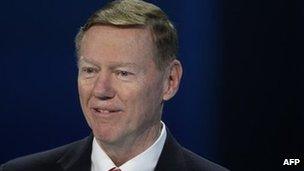Why insiders have the edge when it comes to the top job
- Published

Bill Gates' successors, Steve Ballmer and now Satya Nadella, both came from within Microsoft
When you let your colleagues know you are leaving your job the last thing you want to hear is cheers.
Yet when Steve Ballmer announced his retirement as chief executive of Microsoft in August, shareholders did exactly that, sending the shares up more than 7%.
Holders of the stock, who have seen the once-undisputed tech leader fall far behind rivals such as Google and Apple during Ballmer's 13-year reign, were clearly delighted at the prospect of a new leader.
But those who were hoping for an outsider with fresh ideas were disappointed when Satya Nadella, a 22-year Microsoft veteran, was chosen for the top job.
Critics say Mr Nadella's longevity at the firm suggests that he is not a radical enough thinker.
Yet, research shows Microsoft is in good company by choosing an insider for the job.
According to global consulting firm Booz and Company's most recent annual study, external of the world's largest public companies, when new chief executives were appointed in 2012, insiders were chosen 71% of the time.
And a quarter of these new chief executives had worked at the firm for their entire career.
"Companies often seek familiarity in a new chief executive. Though the companies we studied are large ones, most of which operate on a global scale, they tend to stick close to home when picking a chief executive," said Gary Neilson, from Booz and Company.
Morale boost
The arguments for choosing an internal candidate are well rehearsed: they understand both the firm and the industry, putting them in a good position to initiate the change necessary for growth.
"If a person has developed internally then they are likely to have the trust of the executive board and will have a clear understanding of the culture and how to get things done," says Claire McCartney, adviser at HR industry body, the CIPD.
An internal appointment will also often boost morale - demonstrating to those lower down the ranks what can be achieved if you stick it out for the long term.
"Promoting people internally is a strong retention tool because it allows employees to see the progression opportunities. It is a lot less disruptive and means they avoid rehashing the mistakes of their predecessors," says Neil Owen, global director of recruitment firm Robert Half Financial Services.
However, for internal promotions to be effective, companies need to start examining potential candidates long before a senior staff member calls it quits.
Mr Owen says firms need to determine which positions must never be left vacant in the firm, identify staff with potential and ensure they get the necessary training.
"This needs to happen at all levels in the company. For large organisations with multiple divisions and geographies that takes time, potentially years, and won't breed immediate success."
Familiarity breeds contempt?

Ford boss Alan Mulally publicly ruled himself out of the running to lead Microsoft
But of course entirely home-grown leaders can have their downsides. They will have witnessed, and more than likely helped, to define the firm's strategy - making it harder to challenge and implement changes, particularly if they need to go against colleagues who helped smooth their path to the top.
Meanwhile, they may also have to deal with the spectre of their former boss, or in Mr Nadella's case, bosses.
Outgoing chief executive Steve Ballmer will continue to sit on Microsoft's board, while Bill Gates is also going to be spending more time at the firm in his new role as technology adviser, potentially making it tough for Mr Nadella to shift the firm's direction.
"It's going to be enormously difficult for a new CEO to make the company over again in their image. Finding a way to build on his predecessors' work but also set his own direction is Nadella's absolutely top priority," says Steve Ranger, editor-in-chief of technology websites TechRepublic and ZDNet UK.
Key factor
In his book, The CEO Within, Harvard professor Joseph Bower suggests the compromise is to groom so-called "insider outsiders" as future leaders.
These are internal candidates who somehow have managed to maintain a level of detachment from the firm, despite spending years there.
"These leaders view their role through the lens of someone who just bought the company unencumbered by the cognitive and emotional baggage that comes from a long tenure in the organisation.
"But they also leverage the knowledge they've accumulated about the company's people, suppliers and customers, and future direction," he says.
Ultimately, whether you come from inside or outside the organisation is irrelevant, according to Amanda Goodall, senior lecturer in management at Cass Business School. The key factor is "genuine expertise".
She has researched leadership at hospitals, professional basketball teams and Formula One. In all these cases, Ms Goodall found that organisations whose leaders came from the floor performed the best.
So basketball teams that won the most games were led by former star players, the best hospitals were led by chief executives who were previously doctors, and F1 teams led by former drivers or mechanics won races twice as often as other kinds of leaders.
"The picture my research paints is that chief executives should have a deep understanding of the core business they lead. It's not only about understanding the sector, but also about understanding the business. It points to expert knowledge," she says.
- Published4 February 2014
- Published4 February 2014
- Published4 February 2014